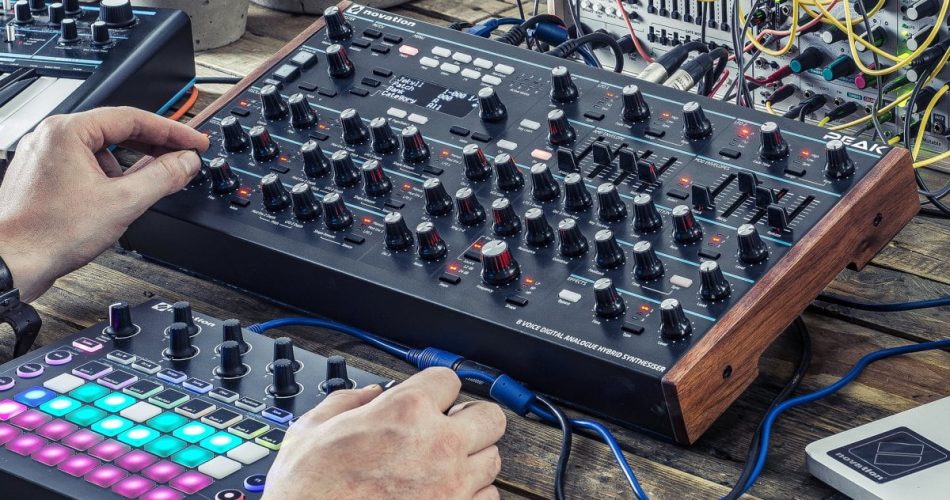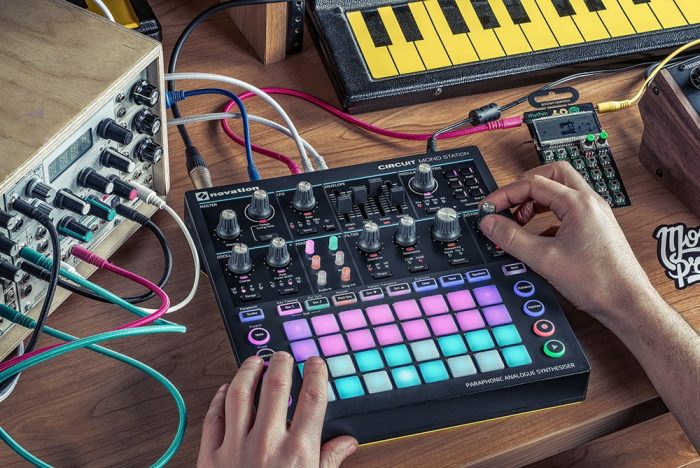Novation has announced its next-generation sequenced monosynth, the Circuit Mono Station.
Circuit Mono Station builds on the 32 velocity-sensitive RGB pads found on Circuit, with a paraphonic analogue synthesizer that originates from the Bass Station II, plus two oscillator sequencers and one modulation sequencer.
With Circuit Mono Station, the sync and tuning parameters of its two oscillators can be individually controlled. It also offers four waveshapes (sawtooth, triangle, square and sample + hold), a sub-oscillator, ring modulation and noise generation. Users can get the frequency band they want by applying high-pass, low-pass and band-pass filters with slopes of 12dB and 24dB. In addition, Circuit Mono Station introduces a powerful overdrive.
Both monophonic and paraphonic modes are available, with each oscillator controlled by its own sequencer. There are three sequencer tracks: two oscillator sequencers and one modulation sequencer. Users can alter gate length, switch patterns instantly, choose sync rate and mutate patterns.
A four-by-eight modulation matrix makes it possible to route from LFO with four waveshapes, envelope, sequencer or velocity, enabling complex modulation for pitch, pulse-width, amp, filter, distortion or CV.
Up to 64 patches can be loaded and saved on the device, right at the user’s fingertips. Circuit Mono Station controls separate hardware via CV, gate and modulation outputs, and has MIDI In, Out and Thru, so other MIDI gear can be connected. Passing an audio signal through the audio input opens up a world of analogue filtration and distortion. Using the audio input with the mod sequencer, a source can be modulated, evolved and processed in entirely new ways. Via USB, Circuit Mono Station can be plugged into Mac or PC, where unlimited patches can be managed using Components.
Circuit Mono Station features
- Two oscillators with individual control of sync and tuning parameters.
- High-pass, low-pass and band-pass filters with slopes of 12dB and 24dB.
- Three distortion modes.
- Choose monophonic or paraphonic modes with individual glide control.
- Four-by-eight modulation matrix that enables complex alteration and routing.
- Load and save up to 64 patches on the device.
- Three sequencer tracks (two oscillator sequencers, one modulation sequencer).
- 32 velocity-sensitive RGB pads.
- 16 scale types.
- Changeable sync rates.
- CV/Gate, CV mod plus MIDI In, Out and Thru for connecting and controlling separate hardware.
- Modulate, evolve and process sources through the audio input.
- Backup patches and sessions with Components.
Circuit Mono Station will be available in July, priced at $499.99 USD (ex. tax) / 549.99 EUR (inc. 19% VAT) / £479.99 GBP (inc. 20% VAT).
Novation has also introduced Peak, an eight-voice polyphonic synthesizer with three New Oxford Oscillators for each voice.
The synth has a resonant multi-mode analogue filter for each voice, and three distortion points in an analogue signal chain.
The oscillators sound completely analogue by being high-quality NCOs (Numerically-Controlled Oscillators), but gain the flexibility of the digital domain with 17 digital wavetables. They can also become a linear FM source using either the analogue-sounding NCOs or digital wavetables – so are able to cross-modulate in a recursive loop.
The synth has a resonant multi-mode analogue filter for each voice, and three distortion points for each voice – pre-filter, post-filter and global – in an analogue signal chain. Peak is capable of receiving polyphonic aftertouch, which puts expression right at your fingertips. Reverb, delay and chorus effects are at one’s disposal, and there is also an on-board arpeggiator.
The modulation system puts a 16-slot modulation matrix and 16 direct assignments in the main controls, cleverly arranged for intuitive patch design and sound editing. There are three ADSR envelopes and two LFOs for each voice, and more elaborate movements and secondary ‘via’ assignments are made just a few menu button presses away. In addition, two animate buttons give live performers instant one-touch transformation of patches.
Peak connects to modular systems via a CV modulation input, and has MIDI I/O on five-pin DIN ports, so other MIDI gear can be connected. Via USB, Peak can be plugged into Mac or PC, where unlimited patches can be kept using the Components software.
Peak features
- Innovative New Oxford Oscillators using two waveform generating techniques: NCOs (Numerically-Controlled Oscillators) and 17 digital wavetables.
- Pre-filter and post-filter distortion per voice, plus global distortion.
- Polyphonic aftertouch and linear FM.
- High-quality reverb, delay and chorus effects.
- Onboard arpeggiator.
- Extensive modulation system, with 16-slot modulation matrix and 16 direct assignments controlled on the front panel.
- Three ADSR envelopes and two LFOs per voice, plus animate buttons.
- CV modulation input for integration with modular systems.
- Compact desktop module design with optional die-cast aluminium stand for positioning (not included).
Peak will be available in May, priced at $1,299.99 USD (ex. tax) / 1,429.99 EUR (inc. 19% VAT) / £1,249.99 GBP (inc. 20% VAT).
More information: Novation





